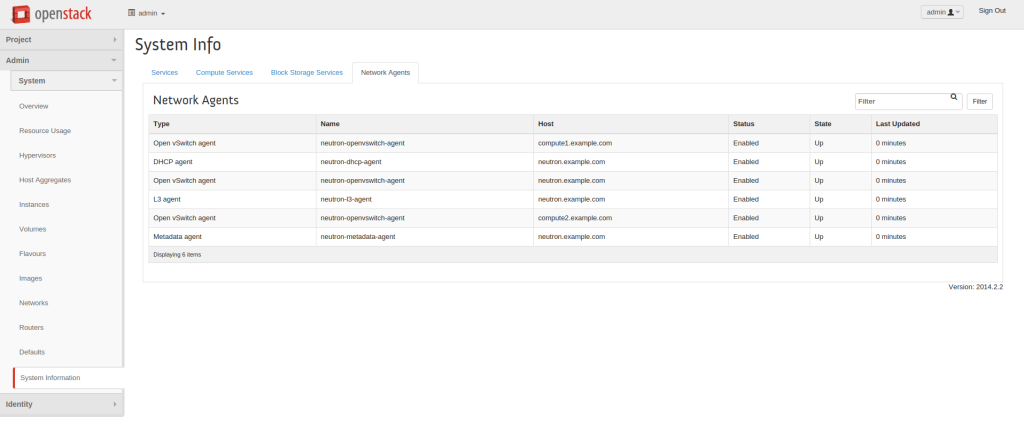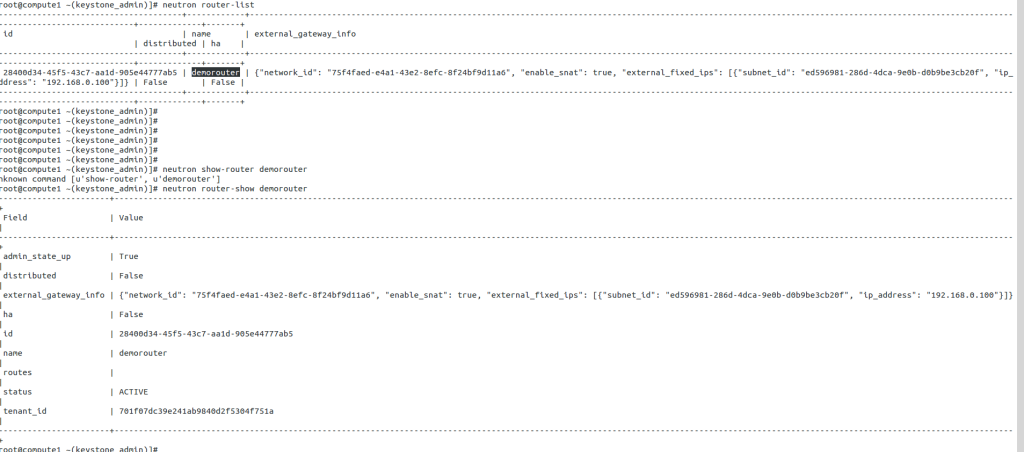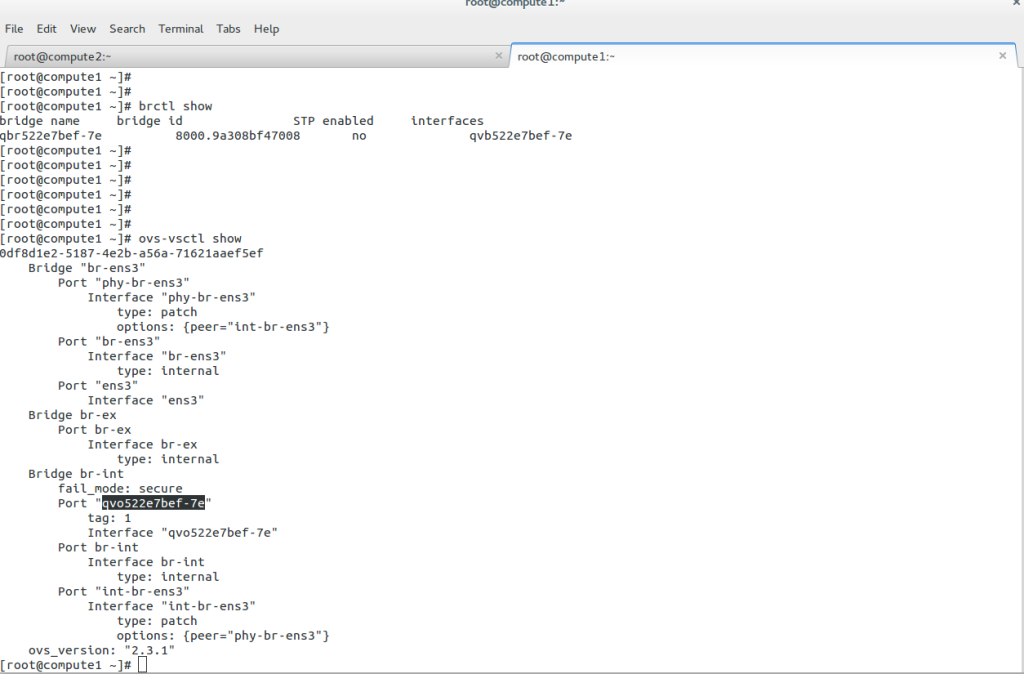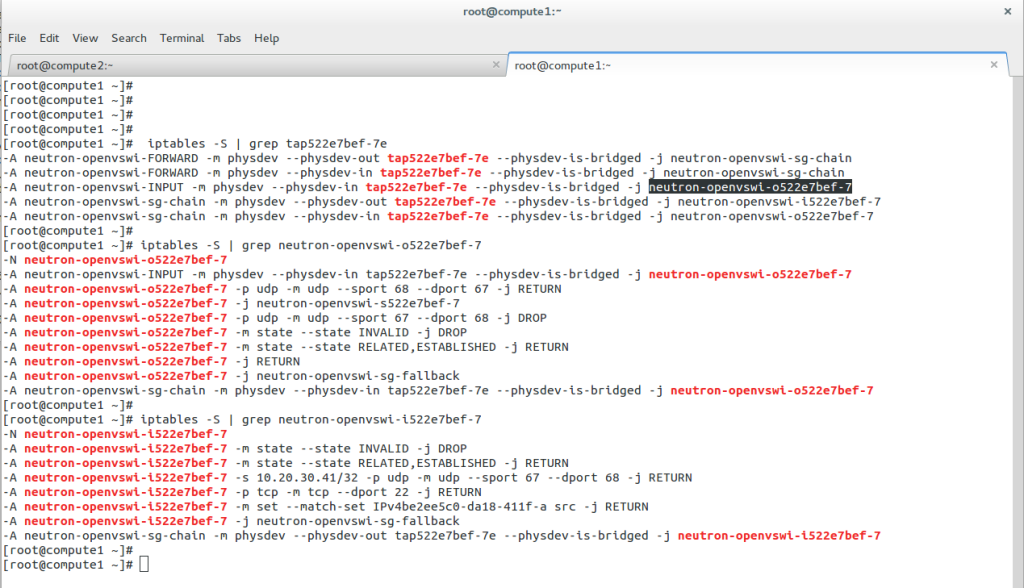OpenStack Neutron
OpenStack Neutron is a powerful networking service that has revolutionized the world of network virtualization. In this blog post, we will delve into the intricacies of OpenStack Neutron and explore its key features and capabilities.
OpenStack Neutron is an integral part of the OpenStack ecosystem, providing a flexible and scalable networking platform for cloud-based applications. It enables users to create and manage networks, subnets, routers, and security groups, offering a comprehensive set of networking services.
One of the standout features of OpenStack Neutron is its support for multi-tenancy. It allows users to create isolated network environments, ensuring secure communication and resource isolation. Additionally, Neutron provides a rich set of APIs for programmatic management, making it highly customizable and adaptable to various network architectures.
OpenStack Neutron enables network virtualization by abstracting the underlying physical infrastructure and providing a virtual networking layer. This allows for efficient resource utilization and seamless scaling of network resources. With Neutron, users can create virtual networks with different topologies, connect them with routers, and define advanced networking policies.
OpenStack Neutron seamlessly integrates with Software-Defined Networking (SDN) technologies, such as OpenFlow and OVS (Open vSwitch). This integration enhances network programmability and enables advanced networking capabilities, such as traffic steering, QoS (Quality of Service), and network slicing.
OpenStack Neutron has transformed the way we approach network virtualization, offering a powerful and flexible networking solution for cloud-based applications. Its rich feature set, seamless integration with SDN technologies, and support for multi-tenancy make it a game-changer in the world of network virtualization.
OpenStack Neutron empowers organizations to build robust and scalable networks, enabling them to leverage the full potential of cloud computing. Whether you are a cloud service provider or an enterprise looking to optimize your network infrastructure, OpenStack Neutron provides the tools and capabilities to meet your networking needs.
Matt Conran
Highlights: OpenStack Neutron
Understanding OpenStack Neutron
– OpenStack Neutron serves as the networking-as-a-service (NaaS) module within the OpenStack framework. It provides a rich set of APIs and tools to manage network resources, allowing users to define and control their network infrastructure programmatically. By abstracting the network layer, Neutron enables the creation and management of virtual networks, routers, subnets, and various networking services.
– Neutron offers a rich set of features that empower users to build and manage complex network topologies within their OpenStack environment. Some notable features include network segmentation, virtual routers, load balancing, firewall-as-a-service, and VPNaaS. These features enable users to create isolated networks, ensure secure communication between resources, and efficiently manage network traffic.
Neutron offers a wide range of features that empower cloud administrators and users to build and manage complex network topologies. Some of the notable features include:
1. Network Abstraction: Neutron allows users to create virtual networks independent of the underlying physical infrastructure, enabling flexible network configurations.
2. Network Security: With Neutron, security groups and access control lists (ACLs) can be defined to control inbound and outbound traffic, ensuring robust network security.
3. Load Balancing: Neutron integrates with load balancing services, enabling the distribution of traffic across multiple instances, enhancing application availability and performance.
The benefits of leveraging OpenStack Neutron are manifold. Firstly, it provides network agility, allowing users to create and modify networks on-demand, eliminating the need for manual intervention. Secondly, Neutron enables network virtualization, which enhances resource utilization and facilitates the creation of multi-tenant environments. Additionally, the extensible nature of Neutron enables integration with a wide range of networking technologies and third-party plugins.
Implementing OpenStack Neutron brings numerous benefits to cloud environments, including:
1. Scalability and Flexibility: Neutron enables the dynamic creation and management of virtual networks, making it easier to scale and adapt to changing business requirements.
2. Network Isolation: By providing network segmentation and isolation, Neutron offers enhanced security and privacy for different tenants and applications within the cloud environment.
3. Automation and Orchestration: Neutron’s programmable APIs allow for automation and orchestration of network resources, reducing manual configuration efforts and enabling rapid deployment.
OpenStack Neutron finds applications in various use cases across different industries. In the telecommunications sector, Neutron enables the creation of virtualized network functions (VNFs), facilitating the deployment of virtualized networking services.
In the enterprise realm, Neutron enables the creation of secure and isolated networks for different departments, improving overall network management and security. Moreover, Neutron plays a pivotal role in public cloud offerings, providing network abstraction and automation.
OpenStack Neutron has gained significant traction in various industries and use cases. Some notable examples include:
1. Service Providers: Telecom operators and service providers leverage Neutron to deliver network services, such as virtual private networks (VPNs) and network function virtualization (NFV).
2. Enterprise Clouds: Enterprises utilize Neutron to build private or hybrid clouds, enabling seamless connectivity and secure communication between different departments and applications.
The role of segregation
In the cloud infrastructure, networking is one of the core services. It must provide connectivity to virtual instances while segregating traffic from different tenants and preventing cross-talk between them. Networking in OpenStack is self-service. As a result, tenants can design their networks, manage multiple network topologies, link networks together, access external networks, and deploy advanced networking services.
Cloud instances are exposed to the external world via networking services, so deploying access control is imperative. As a result of OpenStack networking, firewalls can be created, and tenants can control how their networks are accessed finely.
Virtual machine instances in the Nova project were historically connected by using:
- A flat network comprises a single IP pool and a Layer-2 domain shared by all cloud tenants.
- This type of network separates traffic using VLAN tags. VLAN configuration is required on Layer-2 devices (switches).
Nova still provides these basic networking features; however, Neutron’s OpenStack networking project provides all advanced networking features.
Neutron Features
With its overwhelming features and capabilities, Neutron has become an increasingly effective and robust network project in the OpenStack ecosystem. In addition to networks, subnets, routers, load balancers, firewalls, and ports, it allows operators to build and manage a complete network topology.
Neutron’s API server receives all networking service requests. For scalability and availability, multiple instances of the API server can be deployed on the OpenStack controller node:
- The architecture of Neutron is based on plugins. Neutron plugins provide additional network services.
- Once the API server receives a new request, it is forwarded to a specific plugin, depending on Neutron’s configuration. A Neutron plugin orchestrates the physical resources to instantiate the requested networking feature on the controller node. Resources can be orchestrated directly through a Neutron plugin or via agents:
- The Neutron project provides an open-source implementation of plugins and agents based on OpenStack technologies. An agent can be deployed on a compute node or a network node. Routing, firewalling, load balancing, and VPN services are implemented on network nodes.
- Vendors can implement their plugins and support networking gear by implementing well-defined APIs.
Components Involved
OpenStack Networking with OpenStack Neutron consists of several agents/components. The central entity is the neutron-server daemon, aka the Neutron Server. It consists of a REST service and a Neutron plugin. Plugins essentially enable additional network capability. The Neutron Agent is what the Neutron server communicates with over the message bus.
The Neutron server may well act as the network’s brain, but the agents on the Compute and Network nodes carry out the changes. OpenStack Neutron agents include the L2 agent, L3 agent, and DHCP agent.
For additional pre-information, you may find the following helpful
Highlights: OpenStack Neutron
OpenStack Networking, or Neutron, delivers a network infrastructure-as-a-service platform to cloud users. Neutron constructs the virtual network using features familiar to most system and network administrators, including networks, subnets, ports, routers, and load balancers.
Now, you can configure network topologies by creating and configuring networks and subnets and instructing services like Nova to attach virtual devices to ports on these networks. Users can create multiple networks, subnets, and ports but are limited to thresholds defined by per-project quotas set by the cloud administrator.
Networking as a Service (NaaS):
OpenStack Neutron empowers users to define and manage their network infrastructure using a flexible and programmable API. With NaaS, cloud administrators can create virtual networks, subnets, routers, and security groups, providing tenants complete control over their networking requirements. This flexibility enables seamless integration of existing network infrastructure and facilitates the creation of complex network topologies.
Network Virtualization:
Neutron’s network virtualization capabilities allow isolated and secure virtual networks to be created within a shared physical infrastructure. By leveraging network overlays, such as VXLAN, GRE, and VLAN, Neutron enables the coexistence of multiple tenants on a single physical network. This enhances security and optimizes resource utilization, making it an ideal solution for multi-tenant cloud environments.
Software-Defined Networking (SDN):
OpenStack Neutron embraces the Software-Defined Networking (SDN) concept, enabling network administrators to define network policies and attributes using software rather than relying on hardware configurations. This decoupling of network control and data planes ensures greater flexibility and agility, allowing for rapid provisioning and dynamic adjustment of network resources.
Load Balancing and Firewalling:
Neutron provides built-in load balancing and firewalling services, empowering cloud administrators to manage traffic distribution and enforce security policies effectively. The load balancing service distributes incoming traffic across multiple servers, ensuring high availability and fault tolerance. Similarly, the firewalling service enables the implementation of network security policies, protecting cloud infrastructure from unauthorized access and potential threats.
Integration with Other OpenStack Components:
OpenStack Neutron seamlessly integrates with other OpenStack components, such as Nova (compute), Cinder (block storage), and Keystone (identity), to provide a comprehensive cloud computing environment. This integration enables the dynamic allocation of networking resources based on compute and storage requirements, ensuring efficient utilization of cloud resources.
Ecosystem and Community:
OpenStack Neutron benefits from a vibrant ecosystem and an active community of contributors. With regular updates and enhancements, Neutron evolves with the ever-changing demands of cloud networking. The project’s community-driven nature ensures abundant resources, including documentation, tutorials, and support channels, making it easier for users to adopt and harness the power of OpenStack Neutron.
Neutron Core Plugins
OpenStack Neutron networks have two types of plugins – Core and Service. Core plugins represent Layer 2 base connectivity and IP management. Service plugins represent more advanced networking functionality. The default plugin with OpenStack and probably the most important plugin is the Modular Layer 2 ( ML2) plugin.
It supports VLXAN, VLAN, and GRE connectivity, allowing multiple vendor technologies to coexist. Open vSwitch implements all these technologies, but other 3rd party devices and SDN controllers can orchestrate them.
The following diagram lists the agents installed. Admins may dig deeper into the agent and analyze additional configuration parameters with the neutron agent-show <ID> command.
Port, Subnets, and Networks
The core for Neutron-based clouds is ports, subnets, and networks. Ports contain the IP and MAC address; subnets are the CIDR blocks, and networks are Layer 2 broadcast domains. The current OpenStack Networking API v2.0 allows you to carry out the following actions: list, create, bulk create, show details, update and delete
Ports are created manually or automatically based on user action. For example, a user issues a “set gateway,” which creates a “network:router_gateway” or an “add interface” on a Neutron router. Other ports are auto-created; for example, when Nova creates an instance, we get the “compute: nova” ports. The compute: nova indicates that the port is connected to a virtual machine.
The Network: DHCP indicates that the port is associated with a DHCP server. The network:router_interface is the router’s default gateway for the VMs. This port is associated with a Linux namespace. The network:router_gateway is the port associated with the gateway to the external world. All ports that start with “network” are created on a network node.
The following illustrates the Neutron port list and associated information.
The subnet is the IP address block from which a VM gets its IP address. Every subnet must be associated with a network. Noncontiguous multiple subnets can be assigned to a single network. Networks are isolated Layer-2 broadcast domains, and both ports and subnets are assigned to networks.
There are two categories of networks in Neutron – Tenant and Provider.
Administrators create provider networks and map directly to the physical network. These networks may be flat (untagged) or VLAN (802.1q tagged). Tenant networks are created by users/consumers of the cloud. These networks can be VLAN (802.1q tagged) and tunnel-based.
By default, tenant networks are isolated, and inter-tenant routing is permitted by the Layer 3 agent and Neutron routers. The following screen displays the list of routers; in my lab, I have one called “demo router.”
OpenStack Neutron & VM connectivity
OpenStack Neutron Security Groups
VM instances do not directly connect to the Open vSwitch integration bridge. Instead, they connect to TAP Interfaces on the Linux Bridge. This is due to the restriction between Open vSwitch and iptables. Open vSwitch is not compatible with iptables rules directly applied to TAP interfaces.
As a result, VMs are attached to the Linux Bridge TAP Interfaces, which then connect to the integration bridge. The Linux bridge exists entirely to support iptable firewall rules.
The following screen displays the iptable firewall rules attached to tap522e7xxxxx. The neutron-openvswi-sg-chain is where the Neutron security groups are realized—the neutron-openvswi-o522e7bef-7 controls outbound traffic from the VM, and neutron-openvswi-i522e7bef-7 control inbound traffic to the VM.
The interface port on a VM Ethernet Port VM is emulated and commonly known as a vNIC. An Ethernet port on a Linux Bridge (where the VM connects) is represented by a TAP Interface. The TAP Interfaces connect to the vNIC.
The qvb522e7bef-7e interface attached to the Linux Bridge connects to the Integration Bridge—br-int—qvb522e7bef-7e connects to qvo522e7bef-7e. The ports have a tag of 1.
This illustrates that the port is an access port, and any untagged traffic outbound from the VM is assigned VLAN ID 1. Any inbound traffic with VLAN 1 is stripped and sent to the port. In the following diagram, the command brctl show displays the Linux Bridge, and ovs-vsctl show displays the Open vSwitch. The Open vSwitch has three bridges – br-xxx, with br-int being the main integration bridge.
The Open vSwitch agent
The Open vSwitch agent programs the flows by manipulating traffic traversing the switch. Flow rules can program a specific action, such as adding or stripping a VLAN. The Open vSwitch agent converts information in the Neutron database to flows.
The rules specify a particular inbound port – i.e., in_port=3. Flows with the action of NORMAL inform the switch to act “normal,” forwarding out all ports until it can update the forwarding database.
This is the default learning behavior – flooding all ports until it learns the correct path. The forwarding database is the same as a standard CAM or MAC table. The following diagram illustrates inbound and outbound rules. The “o” and “i” represent the rule direction.
Closing Points on OpenStack Neutron
At its heart, OpenStack Neutron provides dynamic and scalable networking services to cloud users. It empowers them to create and manage networks, subnets, and routers, offering flexibility in setting up their desired network configurations. With Neutron, users can implement various network models, from flat networks to VLANs, and even more advanced tunneling technologies like GRE or VXLAN. This versatility makes Neutron a pivotal tool in crafting efficient and tailored cloud environments.
OpenStack Neutron is built on a modular architecture, with a range of plugins and agents that facilitate network operations. The plugins allow for integration with different network solutions, enabling the deployment of diverse network technologies. Neutron’s architecture includes the server component, which interacts with the OpenStack dashboard and CLI, and various agents that handle network functions on the host machines. This architecture is designed for high availability and scalability, ensuring seamless network management across large-scale cloud deployments.
Implementing OpenStack Neutron offers numerous benefits to cloud infrastructures. It provides a high degree of automation in network management, reducing the manual workload and minimizing errors. Neutron’s ability to support a wide array of networking technologies and protocols allows for enhanced network performance and security. Additionally, its open-source nature ensures that it is continually updated and improved by a vibrant community of developers, keeping it at the cutting edge of network technology.
Summary: OpenStack Neutron
OpenStack Neutron has emerged as a leading networking component in cloud computing. With its robust features and seamless integration, it has revolutionized the way networks are managed and orchestrated. In this blog post, we will delve into the role of OpenStack Neutron, exploring its key functionalities and benefits for cloud infrastructure.
Understanding OpenStack Neutron
OpenStack Neutron serves as the networking-as-a-service (NaaS) component of the OpenStack platform. It provides a flexible and scalable solution for managing networks within a cloud environment. By abstracting the underlying network infrastructure, Neutron allows administrators to efficiently create and manage virtual networks, routers, and security groups.
Key Features and Functionalities
Neutron offers many features that empower cloud operators to build and manage complex network topologies. Some of the key functionalities include:
1. Network Virtualization: Neutron enables the creation of virtual networks, which can be customized and isolated from each other. This provides enhanced security and flexibility when allocating network resources.
2. Load Balancing: With Neutron’s load balancing service, cloud applications can be distributed across multiple servers, ensuring high availability and improved performance.
3. Security Groups: Neutron’s security groups feature allows administrators to define and enforce network access policies. This helps establish secure communication between different instances within the cloud.
Neutron Plugins and Extensions
Neutron’s extensible architecture allows for the integration of various plugins and extensions. These plugins enable additional functionalities, such as software-defined networking (SDN) integration, quality of service (QoS) policies, and network function virtualization (NFV) capabilities. This extensibility ensures Neutron can adapt to diverse networking requirements and integrate with different infrastructure technologies.
Benefits of OpenStack Neutron
The adoption of OpenStack Neutron brings several advantages to cloud infrastructure:
1. Simplified Network Management: Neutron abstracts the complexities of network management, providing a centralized and intuitive interface to manage virtual networks, routers, and security groups. This simplifies the overall network administration process.
2. Enhanced Scalability and Flexibility: With Neutron, cloud operators can quickly scale their networks based on demand. Creating and managing virtual networks dynamically allows for greater flexibility in adapting to changing workload requirements.
3. Improved Security: Neutron’s security groups feature filters and control network traffic, enhancing the cloud environment’s overall security posture. Administrators can define granular access policies, thus reducing the attack surface.
Conclusion:
OpenStack Neutron enables efficient and scalable network management in cloud environments. Its rich features, extensibility, and seamless integration make it a valuable component of the OpenStack ecosystem. By leveraging Neutron’s power, organizations can build robust and secure cloud infrastructures that effectively meet their networking needs.
- DMVPN - May 20, 2023
- Computer Networking: Building a Strong Foundation for Success - April 7, 2023
- eBOOK – SASE Capabilities - April 6, 2023







